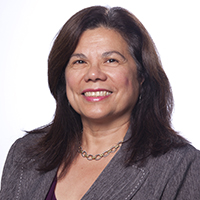Infectious Diseases Expert at Stanford Medicine Children’s Health Discusses 2015 Flu Season in California
For Release: January 14, 2015

STANFORD, Calif. — It’s that time again when many Americans are ringing in the new year with a fever, sniffles and extreme fatigue – otherwise known as the flu. At least 43 states in the U.S. have reported widespread outbreaks and the number of people having to be hospitalized is swelling. As of last week, the California Department of Public Health announced the state’s first death of a person under the age of 65.
In a new Q&A, Yvonne Maldonado, MD, chief of infectious diseases at Lucile Packard Children’s Hospital Stanford and Stanford Medicine Children’s Health, sheds light on influenza trends and how to hopefully avoid the virus this season.
When is flu season?
Maldonado: The season started last month, in early December, and goes through March.
How is the spread of influenza nationwide and in California looking for 2014-15?
Maldonado: Through December, we’ve had more people getting sick nationwide than we had last year, but fewer deaths. Twenty-one pediatric deaths have been reported in the U.S. so far. California is just starting to experience a wider flu outbreak for this season, and is likely to see continued activity of the flu in upcoming months. The state is commonly late compared to the rest of the country.
Is there a particular age group or demographic that is especially at risk?
Maldonado: At this point, the largest group being affected are adults 65 years of age and older. The second group is children 0-4. Individuals with certain underlying chronic diseases, especially respiratory diseases, are at higher risk of severe symptoms.
Which strain are we seeing most this season?
Maldonado: The H3N2 strain of influenza A is much more common this year than the H1N2 strain. The H3N2 strain is typically associated with more severe illness and mortality compared to the H1N1 strain.
Is this year’s vaccine a match for the strain? And why should people get vaccinated now, if they haven’t already?
Maldonado: Unfortunately, this year the H3N2 vaccine is not as good a match as initially expected. However, it still offers some protection. But I can’t stress enough how important it is to get vaccinated. It’s the best tool we have of fighting the flu and we’re only a couple of months into the season. It’s not too late to still be vaccinated.
How can people tell the difference between the flu and the common cold?
Maldonado: A cold is generally a runny nose, runny eyes and a sore throat. It’s uncomfortable, but you can make it through the day with a cold. With the flu, along with the runny nose, runny eyes and sore throat, you likely have a fever and extreme body fatigue – you’re achy all over. You feel like you’ve been hit by a truck and want to just stay in bed.
Besides a flu shot, is there anything proactive a person can do to avoid getting sick?
Maldonado: Both children and adults need to wash their hands after contact with others and after coughing or sneezing. Other than that, there is nothing scientifically proven to prevent flu other than a flu shot. Children should not be given aspirin if they start experiencing flu-like symptoms. Aspirin is associated with liver problems in children who have the flu. Instead, we recommend acetaminophen.
Dr. Maldonado is also Berger-Raynolds Distinguished Fellow and professor of pediatrics and health research and policy and chief of the division of pediatric infectious diseases at the Stanford University School of Medicine, and senior associate dean for faculty development and diversity.
Authors
Robert Dicks
(650) 497-8364
rdicks@stanfordchildrens.org
About Stanford Medicine Children's Health
Stanford Medicine Children’s Health, with Lucile Packard Children’s Hospital Stanford at its center, is the Bay Area’s largest health care system exclusively dedicated to children and expectant mothers. Our network of care includes more than 65 locations across Northern California and more than 85 locations in the U.S. Western region. Along with Stanford Health Care and the Stanford School of Medicine, we are part of Stanford Medicine, an ecosystem harnessing the potential of biomedicine through collaborative research, education, and clinical care to improve health outcomes around the world. We are a nonprofit organization committed to supporting the community through meaningful outreach programs and services and providing necessary medical care to families, regardless of their ability to pay. Discover more at stanfordchildrens.org.
About Stanford University School of Medicine
The Stanford University School of Medicine consistently ranks among the nation’s top medical schools, integrating research, medical education, patient care and community service. For more news about the school, please visit med.stanford.edu/school. The medical school is part of Stanford Medicine, which includes Stanford Health Care and Stanford Medicine Children’s Health. For information about all three, please visit med.stanford.edu.
Connect with us:
Download our App: